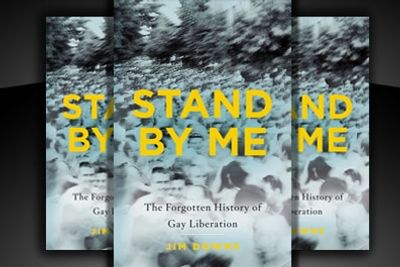By Terri Schlichenmeyer, April 2018 Issue.
You had no idea. How could you know? No one ever told you, nobody sat you down to explain what was what. You were blissfully unaware, kept in the dark for far too long, but read Stand by Me: The Forgotten History of Gay Liberation by Jim Downs, and you may see the light on a few things.
Years ago, when he was a college student, Downs spent evenings with his best friend in a back room in the William Way Lesbian, Gay, Bisexual and Transgender Community Center in Philadelphia, poring through archives. Then, he had no idea of the value of the old newspapers and articles he’d found but after seeing a documentary on the 1970s and AIDS, he suddenly understood.
Bothered by conclusions drawn in the movie – specifically, what he felt was a focus on promiscuous sex – he returned to the archives. It was there that he saw how much of LGBTQ history is unknown or misunderstood. His research led to this book.
One of the more shocking things he discovered was “the largest massacre of gay people in American history.”
It happened on June 23, 1973, in New Orleans: a group of 120 gay, lesbian and straight worshippers were holding a church service on a Sunday night on the second floor of a building in the French Quarter. They were members of the Metropolitan Community Church, which had been established so that LGBTQ individuals had a safe, inclusive place to worship. On that night, they were raising their voices in song when a still-unknown person threw flammable liquid on the stairs, trapping the congregation. Thirty-two people died that night.
Downs writes of a New Yorker with a “vision” of a bookstore-slash-gathering-place for “homophiles” to mingle and share ideas, rather than their bodies. He explains how a soon-to-be-famous writer was relentless in his search for gay history in Nazi Germany. He examines how activism and gay politics spurred the creation of gay newspapers, and how LGBTQ publications affected “people of color” and domestic workers. Coming full-circle, he shows how gay churches and newspapers supported gay men in prison.
In any history, there’ll always be surprises, facts and tales that are forgotten or ignored until someone finds and reveals them anew. And that’s exactly what Downs has done here in Stand by Me.
Starting with upset over what he perceived to be a simplistic premise for a documentary, Downs moves on to a story that was largely ignored by nationwide news outlets, then to activists and beginnings of an LGBTQ press. His narrative encompasses the years roughly prior to Stonewall through about the late 1970s, and it includes a number of coincidental connections that are nicely revealed. This book is informative, sometimes horrifying, interesting and, unlike your old high-school history books, it’s never dry.
Older LGBTQ readers may not see anything new or shocking here, but younger community members will truly find some eye-openers. If you don’t know what you don’t know, Stand by Me will give you some ideas.
